
Eucharistic adoration is a Eucharistic devotional practice primarily in Western Catholicism, but also to a lesser extent in certain Lutheran and Anglican traditions, in which the Blessed Sacrament is adored by the faithful. This practice may occur either when the Eucharist is exposed, or when it is not publicly viewable because it is reserved in a place such as a church tabernacle.

St John's Co-Cathedral is a Roman Catholic co-cathedral in Valletta, Malta, dedicated to Saint John the Baptist. It was built by the Order of St. John between 1572 and 1577, having been commissioned by Grand Master Jean de la Cassière as the Conventual Church of Saint John.

The Valletta Waterfront, is a promenade in Floriana, Malta, mainly featuring three prominent buildings: a church in the middle, the Pinto Stores or the Pinto Wharf on the left, and the Forni Stores or the Forni Shopping Complex on the right. The buildings were originally stores and warehouses, built in the 18th century, and the design is attributed to Andrea Belli.

The Our Lady of Victory Church, formerly known as the Saint Anthony the Abbot Church, was the first church and building completed in Valletta, Malta. In 1566, following the Great Siege of Malta, Grand Master Jean Parisot de Valette and his Order showed interest to build a church in the name of the Nativity of the Virgin as a form of thanksgiving; the construction was funded by De Valette.

St Augustine Church is one of the churches built during the creation of the new city of Valletta, Malta.
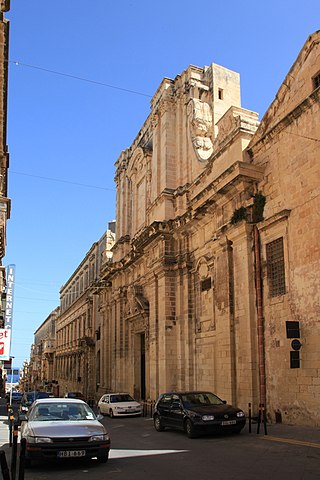
The Church of the Circumcision of Our Lord, commonly known as the Jesuits' church, is one of the oldest churches in Valletta, Malta, and one of the largest in the diocese. It was originally built between 1593 and 1609 by the Jesuit order, and it is located adjacent to the Old University Building, which originally housed a Jesuit college known as the Collegium Melitense. The church was rebuilt in the Baroque style by Francesco Buonamici after suffering extensive damage in an explosion in 1634. The church remained in use after the Jesuits were expelled from Malta in 1768, and it is also used for Masters and Doctoral graduation ceremonies of the University of Malta, the successor to the Collegium Melitense.
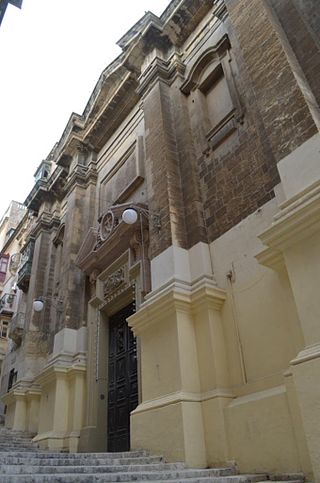
The Franciscan Church of St Mary of Jesus is a church in Valletta, Malta, which is dedicated to St Mary of Jesus and is cared for by the religious order of Friars Minor. It came to be popularly known by the Maltese as Ta' Ġieżu. Ta' Ġieżu is a local corruption of Ta' Ġesù.
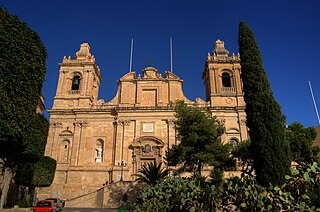
The Collegiate church of Saint Lawrence is an old Church situated in Birgu in Malta.
The Sanctuary of Our Lady of the Sacred Heart in Sliema, Malta was founded in 1877, and has been a parish church since 1918.

Former religious orders in the churches of the Anglican Communion are those communities of monks, nuns, friars, or sisters, having a common life and rule under vows, whose work has ended and whose community has been disbanded. In a very few cases this is due to the termination of the work for which the community was established, but in most cases it is due to amalgamation or the death of the final remaining member of the community.
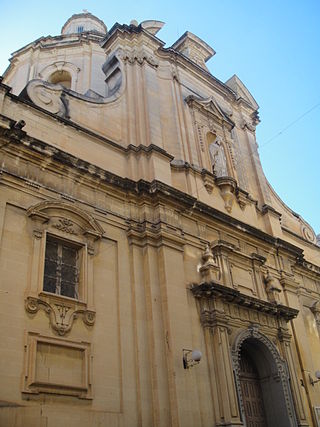
The Church of Saint Nicholas, also known as the Church of All Souls, is a Greek Catholic church in Valletta, Malta, dedicated to Saint Nicholas. Originally built as a Greek Orthodox church in 1569, it was conceded to the Confraternity of the Souls in Purgatory in 1639, who rebuilt the church in the Baroque style in 1652. The church was passed back to the Greek Catholic congregation in 2014 however the church is used from Ecumenical Patriarchate of Constantinople.

The Church of St Mary Magdalene is a Roman Catholic church building in Valletta, Malta. The church, named after Jesus' companion Mary Magdalene, was part of the Magdalene asylum situated adjacent to the church. The church was deconsecrated in the mid 20th century and was blessed again by Bishop Charles Scicluna on 25 February 2015.

The Basilica of St Dominic or also known as the Basilica of Our Lady of Safe Haven and St Dominic is one of the three parish churches of Valletta, Malta. It is administered by the Dominican Order whose convent is located behind the church.

The Church of Our Lady of the Pillar is a 17th-century church located in Valletta, Malta. The church was built as the church of the Aragonese knights and modeled according to the plans of the architect Romano Carapecchia. The church is listed on the National Inventory of the Cultural Property of the Maltese Islands.

The Basilica of Our Lady of Mount Carmel is a Carmelite Roman Catholic minor basilica dedicated to Our Lady of Mount Carmel, located in Valletta, Malta. It is one of the major churches of Valletta, and it forms part of a UNESCO World Heritage Site which includes the entire city. The present church was constructed between 1958 and 1981 on the site of a late 16th century church which was destroyed during World War II.

The Church of St Lucy is a small Roman Catholic church situated in Valletta, Malta. The church was built in 1570 and features a titular painting above the high altar and the corpse of St Lucian, the martyr.

The Parish Church of St Andrew is a Roman Catholic parish church located in Luqa, Malta.

The National Inventory of the Cultural Property of the Maltese Islands (NICPMI) is a heritage register listing the cultural property of Malta. The inventory includes properties such as archaeological sites, fortifications, religious buildings, monuments and other buildings. The NICPMI is under the responsibility of the Superintendence of Cultural Heritage (SCH), which was founded in 2002 to replace the Antiquities Act. The NICPMI was established on 16 December 2011.
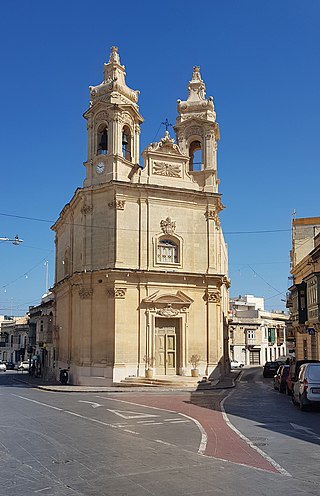
The Old Church of St Sebastian, commonly known as il-knisja ż-żgħira, is a Roman Catholic church in Qormi, Malta, dedicated to Saint Sebastian. It was built between 1880 and 1890 near a statue of the saint which had been erected in 1815 to commemorate deliverance from a plague epidemic in 1813. It was a parish church between 1935 and the 1980s, when a larger parish church with the same dedication was built nearby. The building was only formally consecrated in 2019, and it is now used as an adoration chapel.




















